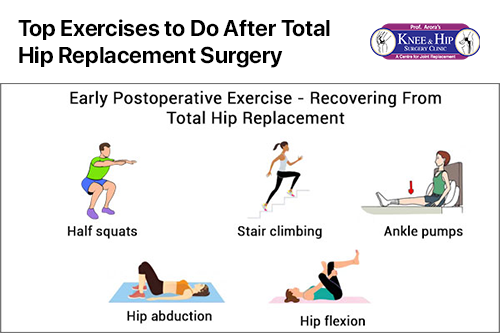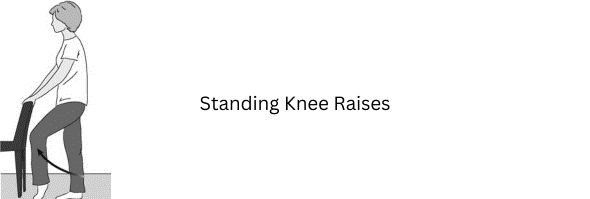
Top Exercises to Do After Total Hip Replacement Surgery
Recovering from total hip replacement surgery can feel like a long journey, but the right exercises can help you heal faster and get back to your everyday life with less pain and more strength. Whether you're just out of surgery or a few weeks into recovery, total hip replacement exercises are essential for rebuilding strength, improving flexibility, and preventing complications.
In this blog, we’ll break down the most effective exercises to do after your surgery — from early movements in bed to advanced activities that help you walk with confidence. Always follow your doctor’s advice before starting any exercise.
Why Exercise After Total Hip Replacement Matters
After your hip surgery, your muscles are weak, your joints are stiff, and your body is adjusting to a new implant. Without regular movement, you risk blood clots, joint stiffness, and slower healing. That’s why total hip replacement exercises play a key role in your recovery.
By following a safe and consistent exercise plan, you can:
- Improve blood flow and avoid clots
- Regain strength in your legs and hips
- Restore flexibility and range of motion
- Speed up your return to normal activities
1. Early Post-Surgery Exercises (While in Bed)
These gentle movements are safe to do soon after surgery — even while you're still in the hospital.
Ankle Pumps
Point your toes up toward your head and then down. Do this every 10 minutes throughout the day. This helps with blood circulation and reduces the risk of blood clots.

Ankle Rotations
Gently rotate your ankles clockwise and then counterclockwise. Do 5 rotations in each direction, a few times daily.
- Start Position: Sit or lie down with your leg extended and your foot elevated slightly off the ground.
- Movement: Slowly rotate your foot in a circular motion — first in one direction (clockwise).
- Reverse Direction: After a few circles, switch and rotate your foot in the opposite direction (counterclockwise).
- Repetitions: Do 10–15 circles in each direction per session.
- Frequency: Repeat several times a day, especially during periods of rest or inactivity.

Bed-Supported Knee Bends
Slide your heel toward your buttocks while keeping your heel on the bed. Bend your knee as far as you comfortably can, hold for 5 seconds, then straighten your leg again. Do this 10 times per session.
- Start Position: Lie down on your back with both legs straight on the bed or floor.
- Movement: Slowly slide one heel toward your buttocks, bending your knee as much as you comfortably can.
- Support: Keep your foot in contact with the surface and your other leg relaxed and straight.
- Hold and Return: Hold the bent position for a few seconds, then slowly slide your foot back to the starting position.
- Repetitions: Repeat this motion 10–15 times with each leg.
- Frequency: Do this exercise several times a day to keep the knee joint flexible.

Buttock Contractions
Tighten your buttocks for 5 seconds, then relax. Do this 10 times, 3 to 4 sessions a day. It’s a small move that helps activate your hip muscles early on.
- Start Position: Lie flat on your back with both legs straight and arms relaxed by your sides.
- Tighten Muscles: Gently squeeze your buttock muscles together, as if you’re trying to lift your hips slightly off the bed.
- Hold: Maintain the squeeze for about 5 seconds.
- Relax: Slowly release the tension and rest for a few seconds.
- Repetitions: Repeat this movement 10–15 times.
- Frequency: Do the exercise several times a day for best results.

These total hip replacement exercises are simple but powerful in helping your body start the healing process.
Visit Here to Know About Revision Hip Replacement: Revision Hip Replacement - Dr. (Prof.) Anil AroraBest Knee ROBOTIC Knee and Hip Replacement Surgeon
 1.png)
Dr. (Prof) Anil Arora
Vice Chairman & Head of Department Orthopaedics & Joint Replacement Surgery, Max Super Speciality Hospital, Patparganj, Delhi Chairman & Chief Surgeon, Prof. Arora's Knee & Hip Surgery Clinics, NCR
Education & Training:
Hospital: Max Super Specialty Hospital
Clinic: Prof. Arora’s Knee & Hip Surgery Clinics, Delhi NCR
Experience: 33+ Years
- Commonwealth Academic Staff Fellowship in Primary, Complex & Revision Joint Replacement Surgery: Royal National Orthopaedic Hospital - Stanmore, London (UK)
- Professor at University College of Medical Sciences & GTB Hospital, New Delhi
- Assistant Professor at Dr SN Medical College & Mahatma Gandhi Hospital, Jodhpur
- Senior Resident at University College of Medical Sciences & GTB Hospital, New Delhi
Specialty: Orthopaedic Joint Replacement (Robotic Knee & Hip Replacement) Max Super Specialty Hospital
About: Prof. Arora, Guinness world record holder and Limca book of records holder, is a Senior Robotic Total Knee & Hip Replacement surgeon. He is an Internationally known figure in Orthopedics and joint replacement. He has been performing joint replacements since 1988, experience of more than 33 years and 12,000 Knee & Hip Replacement surgeries. Teaching in medical college and training Orthopedic surgeons has provided him with vast surgical and clinical experience and expertise. He has wide-ranging skills in knee and hip replacement surgeries. He is known for his sound clinical judgment and fine surgical skills. He was the first surgeon to start pinless computer navigated total knee replacements in north India. He is regularly performing primary, complex and revision (Robotic & pinless computer navigated) knee and hip replacement surgeries. He is also performing primary and revision elbow and shoulder replacements. He is the immediate past president of Delhi Orthopedic association.
2. Standing Exercises (With Support)
Once you're strong enough to stand, it’s time to move your legs more actively. Use a stable surface like a countertop, walker, or rail for balance.
Standing Knee Raises
Lift your operated leg slowly toward your chest, without going higher than your waist. Hold for 2-3 seconds, then lower. Repeat 10 times.

Standing Hip Abduction
Stand straight and lift your leg sideways (out to the side) while keeping your knee straight. Slowly return to the starting position. Repeat 10 times.
- Start Position: Stand upright behind a sturdy chair, holding the back of the chair with both hands for balance.
- Lift the Leg Sideways: Slowly lift one leg out to the side, keeping your back straight and your toes pointing forward.
- Avoid Leaning: Do not lean your upper body to the side while lifting your leg—only your leg should move.
- Hold Briefly: Pause at the top for 1–2 seconds to feel the stretch and muscle engagement.
- Lower Slowly: Gently bring the leg back to the starting position.
- Repeat: Do 10–15 repetitions on one leg, then switch to the other.
- Frequency: Perform 2–3 sets per leg, once or twice a day.

Standing Hip Extensions
Stand and gently swing your leg backward without leaning forward. Hold for 2-3 seconds, then return. This strengthens your glutes and helps improve balance.
- Starting Position: Stand straight while holding the back of a sturdy chair with one or both hands for support.
- Engage Core: Keep your abdominal muscles tight and your upper body upright throughout the exercise.
- Lift the Leg Backwards: Slowly extend one leg straight back, keeping the knee straight and the toes pointing forward.
- Do Not Arch Your Back: Avoid leaning forward or arching your back—only your leg should move.
- Pause Briefly: Hold the raised position for 1–2 seconds.
- Return Slowly: Bring the leg back to the starting position with control.
- Repetitions: Repeat 10–15 times on one leg, then switch to the other leg.
- Frequency: Do 2–3 sets for each leg daily, or as recommended.

These standing total hip replacement exercises improve stability and prepare your body for walking again.
3. Walking and Early Activity
One of the best natural exercises is simply walking. At first, you’ll use a walker or crutches, but as you gain strength, you’ll gradually transition to walking independently.
Walking Tips
- Keep your back straight and walk slowly
- Place your heel on the ground first, then roll through your foot
- Don’t rush — smooth and steady steps matter more than speed
Walking builds endurance, strengthens your legs, and boosts confidence. It’s one of the most important total hip replacement exercises you can do.
4. Advanced Strengthening (3-6 Weeks After Surgery)
As your mobility improves, your therapist may introduce resistance bands or exercise bikes to help you regain muscle strength.
Elastic Band Exercises
Attach a resistance band to your ankle and a stable object like a door handle:
- Resistive Hip Flexion: Pull your leg forward
- Resistive Hip Abduction: Move your leg to the side
- Resistive Hip Extension: Pull your leg backward
Repeat each move 10 times, 4 sessions a day. These resistance-based total hip replacement exercises will strengthen muscles that support your new joint.
Stationary Biking
Begin with a high seat and pedal backward until you’re comfortable. Then slowly move to forward pedaling. Start with 10–15 minutes twice a day and work up to 30 minutes, 3–4 times a week.
Cycling is great for improving hip mobility and rebuilding endurance.
5. Stair Climbing (When You're Ready)
Climbing stairs is both a strength and balance challenge. Start with support and go one step at a time:
- Go up with your good leg
- Come down with your operated leg
Use a handrail and have someone nearby if you need help. Once you’re stronger, you can walk stairs foot-over-foot.
Things to Keep in Mind
- Always check with your physical therapist before starting or changing exercises.
- Never force a movement that causes pain.
- Avoid bending your hip too far or twisting your leg in the wrong direction.
- Progress takes time – be patient and consistent.
Final Thoughts
Recovery from hip surgery may seem slow at times, but the right total hip replacement exercises can make all the difference. Start early, stay consistent, and always follow the guidance of your healthcare team. From ankle pumps to walking and biking, each movement brings you one step closer to a stronger, more active life.
If you’re unsure where to start, speak to a physical therapist or your surgeon for a customized exercise plan. Remember, healing is not just about resting — it’s about moving the right way at the right time.




